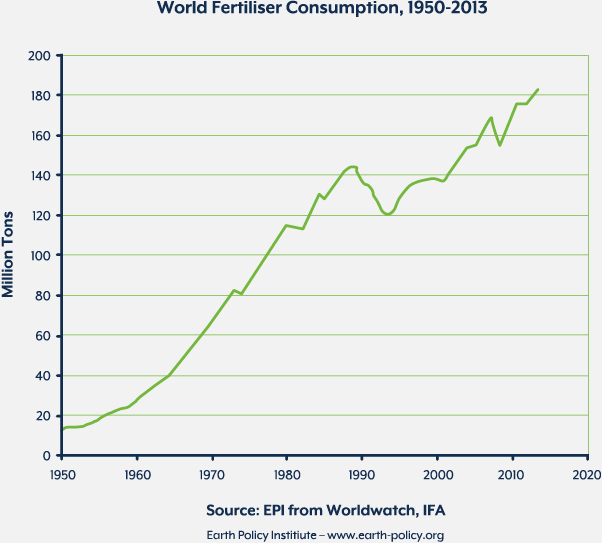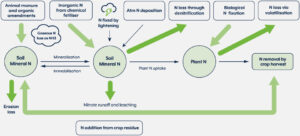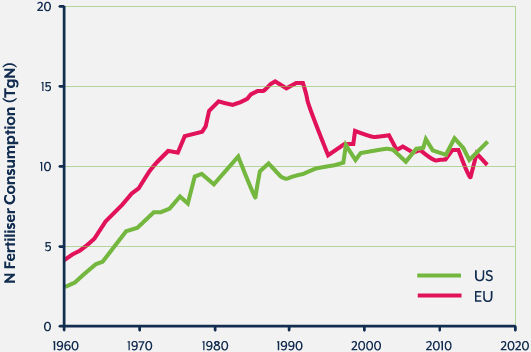The Fertiliser Problem
Our Chief Scientific Officer, Dr. Colin Fleming, has put together a summary to set the scene as to what the current global and agricultural challenges are and how we view chemical fertilisers such as biostimulants as a necessary solution.

Figure 1: Annual Global Fertiliser consumption
Use of fertilisers in agriculture
The agriculture and horticulture sectors have increasingly relied on the various uses of fertilisers as a relatively inexpensive and effective method of supplying crops with essential nutrients (Figure 1).
The Nitrogen Cycle
While these industries have been reasonably successful in meeting the global demand for food, nitrogen fertiliser problems associated with the use of inorganic chemical fertilisers have been increasingly a concern for the industry. For example, nitrogen, the primary macronutrient required for plant growth, is essential for agricultural productivity and the nitrogen cycle is a key element of soil nutrition processes (Figure 2).

Figure 2: Nitrogen cycle (after Mahmud et al., 2021)
The global use of synthetic nitrogen fertilizer has increased 10-fold from 1950 to 2008 (Robertson and Vitousek, 2009).
Similarly, the USDA have reported that the USA consumption of nitrogen fertilizer increased 5x from 1960 to 2014, during which time the average U.S. farm price of nitrogen-sourced fertilizers (e.g. nitrate, ammonium, urea or other organic forms) increased by more than 30 times (USDA ERS, 2019).

Figure 3: Annual Nitrogen fertiliser consumption in the USA and EU (After Van Grinsven et al., 2015)
As well as increased economic costs, there are growing environmental problems linked to usage of inorganic chemical fertilisers:
- Excess nutrients are often washed from the field in runoff leading to pollution of rivers and lakes (Daverede et al., 2004; Moe et al., 1967)
- Nitrogen loss to the atmosphere (e.g ammonia volatilisation, nitrous oxide and NOX emissions) are driving climate change and air quality issues.
- Fertiliser can also become unavailable to the crops through chemical, physical, or biological transformation (Sanchez et al., 2001; Schachtman et al., 1998).
- The industrial production of chemical fertilizers is an energy-intensive process that significantly contributes to global CO2 emissions (Vance, 2001).
Sustainability
To compensate for availability problems and the loss of nitrogen, phosphorous and other nutrients from production systems (e.g. up to 65% N may be lost), growers often need to apply more chemical fertilizer than their crops actually require. Excess nutrient will accumulate in the soil and is then lost into the environment, polluting the air, rivers and lakes (Vance, 2001).
Therefore, it is a key objective of the agriculture and horticultural sectors to accommodate increasing global food demands while tackling concerns over excessive fertiliser use.
Specific problems associated with organic production systems:
Organic fertilizers (e.g. composts, manure) have the advantage of utilising nutrients that are already available in the agro-ecosystem, and unlike inorganic fertilisers, they require little input of energy to be processed. Furthermore, the mineral nutrients that are bound in organic materials may be more stable and are less likely to be washed into water sources or released into the atmosphere (Estavillo et al., 1994; King and Torbert, 2007).
However, organic fertilizers have the disadvantage of not always supplying crops with nutrients in an easily absorbable, water-soluble form and at the times when the crops require them (Chen, 2006).
Can biostimulants help?
Clearly, we need to use less fertiliser and minimise nutrient losses to the wider environment. So how can agriculture address these problems? One approach is to enable plants to take up nutrients more efficiently so allowing producers to use less fertiliser. We can also help plants to use the nutrients they have accessed more efficiently. It is here that biostimulants can help.
There is an abundance of evidence demonstrating that biostimulants can improve crop growth and yield, nutritional quality, and abiotic and biotic stress (Colla and Rouphael, 2015). Importantly, plant biostimulants can also be an effective tool in enhancing soil nutrient availability, plant nutrient uptake and nutrient assimilation (De Pascale et al., 2017).
Over the following weeks we will share more research to demonstrate how biostimulants positively impact the environment, and how they are a brilliant solution to the fertiliser problem.

